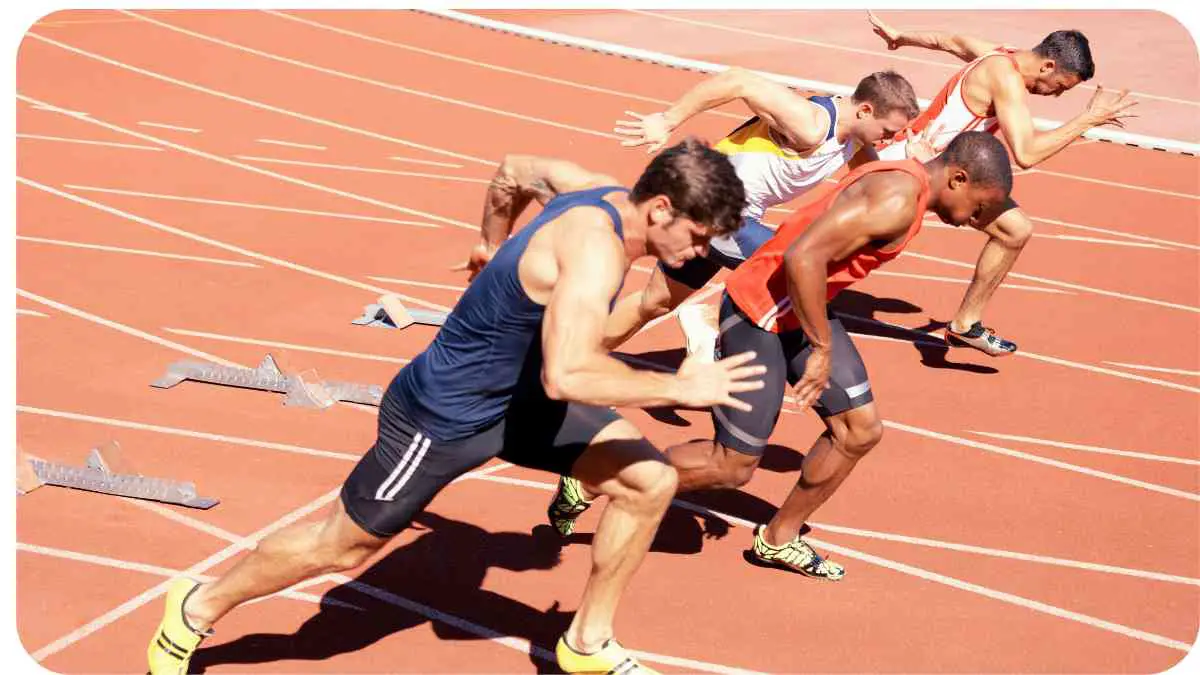Discover the secrets to mastering the 100-meter dash and unlocking your full sprinting potential. From genetic factors to training techniques, this comprehensive guide explores every aspect influencing your race against the clock.
Whether you’re a seasoned athlete or a beginner, this updated article provides valuable insights to help you optimize your performance and achieve your personal best.
| Takeaways |
|---|
| The time it takes for a person to run 100 meters can vary based on factors such as fitness level, training, and athleticism. |
| Average times for running 100 meters range from 15 to 20 seconds for an adult with moderate fitness levels. |
| World record times for the 100-meter dash currently stand at 9.58 seconds for men and 10.49 seconds for women. |
| Improving speed in the 100 meters requires a combination of strength training, sprint-specific workouts, proper technique, and rest and recovery. |
| Common sprinting mistakes to avoid in the 100 meters include starting too quickly, tensing up the upper body, and overstriding. |
| Warming up before the 100-meter sprint is important and should include dynamic stretching, jogging, strides, and mobility drills. |
Unlocking Human Potential
The human body stands as a testament to incredible design, a complex machine finely tuned for speed and endurance. Remarkably, it possesses the capacity to cover 100 meters in under ten seconds. This prowess is not just a result of millions of years of evolution; it’s a canvas upon which you can paint improvements.
By embracing fundamental training principles, you can elevate your running ability and accelerate your sprinting time. In this journey, evolution’s blueprint meets your commitment to unlocking the full potential of your body.
When it comes to running, knowing the right time to replace your running shoes is crucial for optimal performance and injury prevention. Check out our guide on how often should running shoes be changed to ensure you’re getting the most out of your footwear.
Fairness in the 100m Dash

The 100m dash is a timed spectacle, demanding each competitor to cross the finish line within 10 seconds to avoid disqualification. Yet, the race’s dynamics extend beyond the clock. While the clock ticks relentlessly until the last runner concludes, an intriguing element emerges opportunity amid fatigue.
If you find yourself trailing as competitors tire or succumb to injuries, your ability to sustain or increase speed could position you for an unexpected victory.
However, the narrative transcends mere speed; endurance claims a significant role. The race evaluates not only how swiftly you navigate the distance but also your capacity to endure without succumbing to fatigue. Should exhaustion set in prematurely, the risk of being overtaken becomes a tangible threat, emphasizing the multifaceted nature of the 100m dash.
| Event Type | Description |
|---|---|
| Sprint Races | Variation in starting positions and lane assignments can impact race outcomes. |
| Marathon Races | Variation in course terrain, weather conditions, and hydration station placement can create unfair advantages or disadvantages. |
| Track and Field Competitions | Differences in equipment quality, training resources, and funding can affect athletes’ performance and fairness. |
| Relay Races | Unequal distribution of team members’ abilities or relay baton mishandling can impact the final result. |
| Competitive Selection | In some cases, selection biases or favoritism may influence who gets to participate in certain running events. |
| Professional Contracts | Disparities in sponsorship opportunities and financial support can create unequal conditions for professional runners. |
The Genetic Influence on Sprinting
The role of genetics in the pursuit of speed is undeniable when it comes to running 100 meters. Some individuals are inherently bestowed with a natural gift for speed, while others may not share the same genetic predisposition.
However, the encouraging truth prevails genetics do not irrevocably dictate your limits. The pathway to improvement unveils itself through the synergy of hard work and dedicated training. While genetic factors may set the stage, your commitment and effort on the track can redefine the script.
For those embarking on the journey to enhance speed, insightful tips await to propel you forward. This guide provides a starting point, ensuring you step onto the path of becoming a faster, more formidable sprinter.
Looking to improve your running speed? Understanding how to lengthen your stride can help you cover more ground with each step. Check out our article on how to lengthen your stride when running to discover effective techniques and unlock your potential.
Weight’s Impact on Sprinting Performance
Weight is a pivotal factor influencing the dynamics of sprinting, particularly in the context of the 100 meters. The correlation is straightforward: the heavier you are, the more energy is expended in the act of running. This heightened energy demand, in turn, poses challenges for acceleration and deceleration.
Consider a scenario where a heavier individual matches the speed of a lighter counterpart in a 100-meter sprint; the consequence is evident the heavier person requires more time to cover the distance.
Beyond energy expenditure, the impact force during each foot strike becomes a critical consideration. This force, proportional to mass (m) multiplied by acceleration due to gravity (g), underscores the intensity of each step. While constant-speed running may seem less intense than activities like sprinting or jumping rope, the cumulative effect of these forces can’t be underestimated.
Importantly, the additional pounds translate to increased pressure on joints and bones. Over time, this heightened pressure elevates the risk of injury, emphasizing the need for a nuanced approach to managing weight in the pursuit of optimal sprinting performance.
Impact of Shoes on Sprinting Performance

Choosing the right footwear is a pivotal decision that can significantly influence your sprinting prowess, particularly in the context of the 100 meters. The impact is not marginal; in fact, the wrong pair of sneakers can impede your running time by a substantial 0.7 seconds.
For optimal performance, the importance of shoe selection is twofold. Firstly, shoes with adequate cushioning prove indispensable for longer distances, ensuring sustained comfort and support. However, the dynamics shift when it comes to shorter sprints like the 100 meters—here, shoes with reduced padding emerge as the preferred choice.
Equally crucial is the thickness of the shoe sole. A thin sole is paramount, allowing unhindered and swift movement, whether you’re propelling yourself forward or executing a precise stop in the final lap of your pursuit for victory. The right shoes, tailored to the specific demands of the sprint, can indeed make the difference between a fraction of a second and sprinting triumph.
| Brand | Model | Key Features | Performance Benefits |
|---|---|---|---|
| Nike | ZoomX Vaporfly NEXT% | Carbon fiber plate, lightweight foam, energy return | Improved energy efficiency and faster race times. |
| Adidas | Adizero Adios Pro | EnergyRods, lightweight design, responsive cushioning | Enhanced propulsion and increased speed. |
| Hoka One One | Carbon X | Carbon fiber plate, cushioned midsole, rocker design | Smooth and efficient transitions, reduced fatigue, and enhanced stability. |
| Brooks | Hyperion Elite 2 | Nitrogen-infused DNA ZERO foam, carbon fiber plate | Lightweight and responsive with excellent energy return. |
| New Balance | FuelCell TC | Full-length carbon plate, FuelCell foam, propulsion ridges | Efficient energy transfer and enhanced forward momentum. |
| Saucony | Endorphin Pro | SPEEDROLL technology, PWRRUN PB foam, carbon fiber plate | Smooth, propulsive ride and improved performance. |
The Significance of Running Form
Beyond mere aesthetics, running form stands as a pivotal element influencing both speed and injury prevention. It’s not just about looking good on the track; it’s about optimizing your performance and safeguarding against potential injuries.
Effective running form is a dynamic ally, contributing to both forward momentum and efficiency. As we delve deeper into this article, we’ll unravel the basics of form improvement, providing you with actionable insights to refine your technique.
Remember, the way you move on the track isn’t just about style it’s a critical determinant in your sprinting success and longevity as a runner. Stay tuned for essential tips on enhancing your running form.
The Driving Force Behind Sprinting Speed
In the realm of sprinting, the equation is clear: more muscle translates to faster running. The question then arises how much muscle is enough?
The resounding answer: a substantial amount! While the swiftest sprinters may not always be the largest athletes, they undeniably possess considerable muscle mass. Muscle emerges as a critical factor, serving as the powerhouse propelling runners forward.
Three primary types of muscle attributes come into play:
- Muscle Strength and Endurance: Determined by an athlete’s capacity to lift and sustain weight over time.
- Muscle Mass: Signifying an athlete’s weight relative to their height.
- Muscle Power: Reflecting the force generated over time.
This trifecta of muscle characteristics constitutes the foundation for sprinting prowess. Stay tuned as we explore strategies to optimize each facet, unlocking the full potential of your muscles for a faster, more formidable sprint.
Camping and running often go hand in hand, but it’s essential to have a comfortable sleeping arrangement for a good night’s rest. Learn how to make your own camping pad with our easy-to-follow guide on making a camping pad. Sleep better on your outdoor adventures!
Unveiling the Role of Energy
Contrary to common belief, sprinting success isn’t solely dictated by speed and strength. At the heart of a compelling 100-meter dash lies the pivotal factor—energy. This indispensable component is the chief determinant of how swiftly an individual can cover the distance, intertwining with various factors, including body mass and composition.
In the intricate equation of sprinting, energy takes center stage, represented by the formula:
Energy=mass×velocity2Energy=mass×velocity2
This formula underscores the dynamic interplay between an athlete’s mass and the square of their velocity. Join us as we unravel the nuances of energy management, unveiling the key to unlocking unparalleled speed in the exhilarating sprint.
Unveiling Gender Dynamics
In the realm of the 100-meter dash, a noteworthy gender asymmetry emerges—men exhibit an average speed advantage of about 10% over women. This disparity extends beyond mere differences in muscle mass or height, delving into nuanced factors that intricately shape sprinting prowess.
The real differentiator lies in body fat percentage and the center of gravity. Men, boasting a higher proportion of lean muscle mass and less fat, possess distinct physiological attributes. Conversely, women, characterized by wider hips and a higher center of gravity, encounter a unique dynamic in their sprinting journey.
This dichotomy extends beyond mere statistics; it unfolds in the mechanics of acceleration. Understanding these gender-specific factors sheds light on the nuanced challenges and advantages inherent in the 100-meter dash. Stay tuned for a deeper exploration of these intricacies and their profound impact on sprinting performance.
Ageless Velocity
In the realm of the 100-meter dash, age stands as an inconsequential metric in the pursuit of speed. The current world record holder, a vibrant 28-year-old, exemplifies that sprinting prowess transcends age constraints. Further emphasizing this point, the silver medalist in the same race defies conventional expectations, boasting an age over 80.
While age proves irrelevant on the sprinting track, acknowledging the undeniable reality that younger athletes possess the capacity to endure more rigorous and prolonged training becomes imperative. This recognition serves not to limit the potential of older competitors but rather highlights the resilience and dedication of those who persist in defying the perceived boundaries of age in the electrifying sprint.
| Age Group | Notable Athlete | Sport | Achievements |
|---|---|---|---|
| 40+ | Tom Brady | American Football | 7-time Super Bowl champion, multiple MVP awards. |
| 50+ | Meb Keflezighi | Distance Running | 2004 Olympic silver medalist, 2014 Boston Marathon champion. |
| 60+ | Dara Torres | Swimming | 12-time Olympic medalist, competed in the Olympics at age 41 and 45. |
| 70+ | Ed Whitlock | Long-Distance Running | Set numerous age-group records, including a sub-3-hour marathon at age 72. |
| 80+ | Orville Rogers | Track and Field | Multiple world records in masters’ events, including the 60-meter dash. |
The Essence of Conditioning in Sprinting
For casual runners or those new to formal sport training, embarking on a journey to enhance sprinting prowess necessitates strategic conditioning. Collaborating with a coach or trainer becomes pivotal for tailored guidance in this transformative process.
Crucially, it’s vital to distinguish running-specific conditioning from generic “cardio” exercises like cycling or stair climbing. Tailored to fortify muscles essential for running primarily targeting the glutes and lower leg muscles running-specific conditioning emerges as the cornerstone.
Incorporating exercises focused on refining technique amplifies the effectiveness of your conditioning regimen. Plyometrics emerges as a powerhouse for speed augmentation, while balance drills hone efficiency by minimizing extraneous movements during each stride.
As your baseline fitness solidifies, achieving the milestone of running 100 meters under 15 seconds at least twice signifies readiness for advanced training methodologies. From interval training to hill sprints, introducing variety ensures an engaging routine, steering clear of monotony on the journey to sprinting excellence.
For runners who enjoy music festivals, combining the two can be an incredible experience. Ensure you have a successful time with our tips on how to survive a camping music festival. Stay prepared, make the most of the event, and keep up your running routine amidst the fun!
The Crucial Role of Nutrition and Hydration
Achieving peak sprinting performance hinges on more than just physical training; it demands meticulous attention to nutrition and hydration. A poor diet and inadequate sleep compromise your body’s recovery post a demanding run, hindering muscle rejuvenation and energy restoration.
Eating right is paramount. Your muscles, the driving force behind your sprints, crave a nourishing diet to replenish energy stores. Similarly, hydration emerges as a non-negotiable aspect, especially in the face of exercise or extended runs. Whether navigating hot weather or covering long distances, staying adequately hydrated is pivotal.
It’s essential to recognize that water loss occurs not just through sweat but also through breathing. Even in the absence of visible perspiration, dehydration can stealthily set in. Depending on individual sweat rates, your body may demand up to 1 liter per hour of activity.
In the intricate dance of sprinting excellence, a harmonious balance between proper nutrition and hydration is the key to unlocking your full potential on the track. Stay tuned as we delve deeper into the nuances of optimizing your fueling strategy for sprinting success.
The Impact of Weather on Sprinting Performance
In the pursuit of optimal sprinting times, acknowledging the influence of weather conditions is paramount. Even for seasoned runners, the elements can prove to be decisive factors.
Consider the nuances of temperature on a cold day, the inability of body heat to dissipate swiftly can impede movement, creating a drag on speed. Conversely, excessive heat poses its own challenges, hastening dehydration and further contributing to a slowdown in speed.
Windy days add an additional layer of complexity. Strong gusts become formidable adversaries, hindering runners from reaching their maximum speed potential. The extra friction caused by air resistance acts as a subtle yet impactful force, subtly slowing down sprint times.
As we navigate the multifaceted terrain of sprinting excellence, understanding and adapting to varying weather conditions emerge as essential components in the quest for unparalleled speed. Stay tuned as we explore strategies to navigate and conquer the challenges posed by the ever-changing elements.
Unraveling the Impact of Track Surface on Sprinting

Every sprint unfolds on a canvas defined by the track surface, and its characteristics wield a substantial influence on performance. The surface, whether flat and smooth or inclined and sloped, acts as a silent collaborator or adversary in the pursuit of speed.
A “flat” or “smooth” surface, devoid of dips or bumps, provides an optimal runway for swift sprints. Here, runners can unleash their full potential without the encumbrance of uneven terrain, maximizing their efficiency.
Conversely, an “inclined” or “sloped” surface introduces a gravitational challenge. Whether ascending or descending, the force of gravity tugs at the runner, either aiding or hindering their propulsion. Running on such a surface adds an extra layer of complexity, demanding heightened effort and strategy to navigate the incline or decline.
Curious about the incredible speed of greyhounds? These remarkable dogs are renowned for their agility and velocity. Discover firsthand accounts and fascinating insights in our article on how fast can greyhounds run. Learn more about the impressive abilities of these majestic animals.
Unraveling the Impact of Track Surface on Sprinting
Every sprint unfolds on a canvas defined by the track surface, and its characteristics wield a substantial influence on performance. The surface, whether flat and smooth or inclined and sloped, acts as a silent collaborator or adversary in the pursuit of speed.
A “flat” or “smooth” surface, devoid of dips or bumps, provides an optimal runway for swift sprints. Here, runners can unleash their full potential without the encumbrance of uneven terrain, maximizing their efficiency.
Conversely, an “inclined” or “sloped” surface introduces a gravitational challenge. Whether ascending or descending, the force of gravity tugs at the runner, either aiding or hindering their propulsion. Running on such a surface adds an extra layer of complexity, demanding heightened effort and strategy to navigate the incline or decline.
Conclusion
Armed with insights into the myriad factors influencing your 100-meter dash time, it’s time to lace up and hit the track. This article has unraveled the intricate web of elements shaping your sprinting performance, offering a deeper understanding of what unfolds beyond the finish line.
As you prepare to put theory into practice, remember that the journey to sprinting excellence is nuanced and multifaceted. Whether it’s refining your running form, optimizing nutrition, or navigating diverse track surfaces, each aspect plays a crucial role in unlocking your full potential.
Should questions or concerns arise on your sprinting odyssey, our team is here to guide you. Reach out for support, advice, or to share your victories. As you venture into the world of sprinting, may your strides be swift and your pursuit of speed be relentless. Happy running!
Further Reading
Here are some additional resources for further reading on the topic of running and the average time it takes to run 100 meters:
- What’s a Normal Time to Run 100 Meters?: This blog post provides insights into what can be considered a normal time for running 100 meters and offers information to help you gauge your own performance.
- Average 100m Time: How Does Your Speed Compare?: This website explores the average time it takes to run 100 meters, giving you an idea of where you stand compared to other runners and providing motivation for improvement.
- The Perfect 100 Meters: How to Run the Olympics’ Fastest Event the Right Way: This ESPN feature dives into the nuances of running the 100-meter event at the Olympics, providing valuable insights and tips from experts in the field.
FAQs
Here are some frequently asked questions (FAQs) related to running the 100 meters:
How long does it take for an average person to run 100 meters?
On average, an adult with moderate fitness levels can complete 100 meters in around 15 to 20 seconds, although individual times may vary based on factors such as training, age, and athleticism.
What is the world record time for running 100 meters?
As of my knowledge cutoff in 2021, the current men’s world record for the 100-meter dash is held by Usain Bolt of Jamaica, with a time of 9.58 seconds. The women’s world record is held by Florence Griffith-Joyner of the United States, with a time of 10.49 seconds.
How can I improve my speed in the 100 meters?
Improving speed in the 100 meters requires a combination of training techniques, including strength and power exercises, sprint-specific workouts, proper form and technique, and adequate rest and recovery. Working with a coach or trainer can help develop a tailored program to enhance your performance.
What are some common sprinting mistakes to avoid in the 100 meters?
Common sprinting mistakes to avoid include starting too quickly, tensing up the upper body, overstriding, not maintaining proper arm swing, and neglecting strength training. Focusing on these aspects and working on technique can help optimize your performance in the 100 meters.
Are there any specific warm-up exercises recommended for the 100 meters?
Yes, warming up before the 100-meter sprint is crucial for injury prevention and optimal performance. Recommended warm-up exercises include dynamic stretching, jogging, strides, high knees, butt kicks, and mobility drills to prepare your muscles and joints for the intense sprinting effort.

Hellen James is an outdoor enthusiast, writer, and hiker. She loves to explore the world around her by immersing herself in nature and visiting new places.


